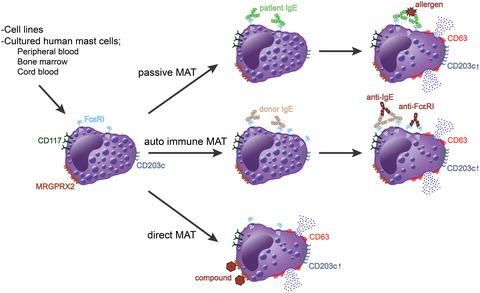当前位置:
X-MOL 学术
›
Clin. Exp. Allergy
›
论文详情
Our official English website, www.x-mol.net, welcomes your
feedback! (Note: you will need to create a separate account there.)
Mast cell activation tests by flow cytometry: A new diagnostic asset?
Clinical & Experimental Allergy ( IF 6.3 ) Pub Date : 2021-07-07 , DOI: 10.1111/cea.13984 Jessy Elst 1 , Marie-Line M van der Poorten 1, 2 , Athina L Van Gasse 1, 2 , Leander De Puysseleyr 1 , Margo M Hagendorens 1, 2 , Margaretha A Faber 1 , Michel Van Houdt 1 , Egle Passante 3 , Rajia Bahri 4 , Mark Walschot 1 , Christel Mertens 1 , Chris H Bridts 1 , Vito Sabato 1, 5 , Didier G Ebo 1, 5
Clinical & Experimental Allergy ( IF 6.3 ) Pub Date : 2021-07-07 , DOI: 10.1111/cea.13984 Jessy Elst 1 , Marie-Line M van der Poorten 1, 2 , Athina L Van Gasse 1, 2 , Leander De Puysseleyr 1 , Margo M Hagendorens 1, 2 , Margaretha A Faber 1 , Michel Van Houdt 1 , Egle Passante 3 , Rajia Bahri 4 , Mark Walschot 1 , Christel Mertens 1 , Chris H Bridts 1 , Vito Sabato 1, 5 , Didier G Ebo 1, 5
Affiliation

|
Since the late nineties, evidence has accumulated that flow-assisted basophil activation test (BAT) might be an accessible and reliable method to explore the mechanisms governing basophil degranulation and diagnostic allowing correct prediction of the clinical outcome following exposure to the offending allergen(s) and cross-reactive structures for different IgE-dependent allergies and particular forms of autoimmune urticaria. Although the BAT offers many advantages over mediator release tests, it is left with some weaknesses that hinder a wider application. It is preferable to perform the BAT analysis within 4 h of collection, and the technique does not advance diagnosis in patients with non-responsive cells. Besides, the BAT is difficult to standardize mainly because of the difficulty to perform large batch analyses that might span over several days. This article reviews the status of flow cytometric mast cell activation test (MAT) using passively sensitized mast cells (MCs) with patients' sera or plasma (henceforth indicated as passive MAT; pMAT) using both MC lines and cultured MCs in the diagnosis of IgE-dependent allergies. In addition, this paper provides guidance for generating human MCs from peripheral blood CD34+ progenitor cells (PBCMCs) and correct interpretation of flow cytometric analyses of activated and/or degranulating cells. With the recent recognition of the mas-related G protein-coupled receptor X2 (MRGPRX2) occupation as a putative mechanism of immediate drug hypersensitivity reactions (IDHRs), we also speculate how direct activation of MCs (dMAT)—that is direct activation by MRGPRX2 agonists without prior passive sensitization—could advance paradigms for this novel endotype of IDHRs.
中文翻译:

流式细胞术的肥大细胞活化测试:一种新的诊断资产?
自 90 年代后期以来,已有证据表明流动辅助嗜碱性粒细胞活化试验 (BAT) 可能是探索嗜碱性粒细胞脱粒和诊断机制的一种可访问且可靠的方法,从而可以正确预测暴露于有害过敏原后的临床结果不同 IgE 依赖性过敏和特定形式的自身免疫性荨麻疹的交叉反应结构。尽管 BAT 提供了许多优于中介发布测试的优势,但它仍然存在一些阻碍更广泛应用的弱点。最好在收集后 4 小时内进行 BAT 分析,并且该技术不会促进对无反应细胞患者的诊断。除了,BAT 难以标准化,主要是因为难以进行可能跨越数天的大批量分析。本文回顾了使用被动致敏肥大细胞 (MCs) 和患者血清或血浆(以下称为被动 MAT;pMAT)的流式细胞术肥大细胞活化试验 (MAT) 使用 MC 系和培养的 MCs 诊断 IgE 的现状-依赖性过敏。此外,本文还为从外周血 CD34 生成人类 MCs 提供了指导。+祖细胞 (PBCMC) 和活化和/或脱粒细胞的流式细胞仪分析的正确解释。随着最近认识到 mas 相关的 G 蛋白偶联受体 X2 (MRGPRX2) 占据作为速发型药物超敏反应 (IDHR) 的推定机制,我们还推测 MCs (dMAT) 的直接激活 - 即 MRGPRX2 的直接激活没有事先被动致敏的激动剂 - 可以推进这种新型 IDHR 内型的范例。
更新日期:2021-07-07
中文翻译:

流式细胞术的肥大细胞活化测试:一种新的诊断资产?
自 90 年代后期以来,已有证据表明流动辅助嗜碱性粒细胞活化试验 (BAT) 可能是探索嗜碱性粒细胞脱粒和诊断机制的一种可访问且可靠的方法,从而可以正确预测暴露于有害过敏原后的临床结果不同 IgE 依赖性过敏和特定形式的自身免疫性荨麻疹的交叉反应结构。尽管 BAT 提供了许多优于中介发布测试的优势,但它仍然存在一些阻碍更广泛应用的弱点。最好在收集后 4 小时内进行 BAT 分析,并且该技术不会促进对无反应细胞患者的诊断。除了,BAT 难以标准化,主要是因为难以进行可能跨越数天的大批量分析。本文回顾了使用被动致敏肥大细胞 (MCs) 和患者血清或血浆(以下称为被动 MAT;pMAT)的流式细胞术肥大细胞活化试验 (MAT) 使用 MC 系和培养的 MCs 诊断 IgE 的现状-依赖性过敏。此外,本文还为从外周血 CD34 生成人类 MCs 提供了指导。+祖细胞 (PBCMC) 和活化和/或脱粒细胞的流式细胞仪分析的正确解释。随着最近认识到 mas 相关的 G 蛋白偶联受体 X2 (MRGPRX2) 占据作为速发型药物超敏反应 (IDHR) 的推定机制,我们还推测 MCs (dMAT) 的直接激活 - 即 MRGPRX2 的直接激活没有事先被动致敏的激动剂 - 可以推进这种新型 IDHR 内型的范例。











































 京公网安备 11010802027423号
京公网安备 11010802027423号